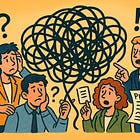Consultant’s Survival Kit: Handling Uncertainty Like a Pro
Confidence isn’t about having all the answers. It’s about moving forward when no one else does
If there’s one constant in consulting, it’s uncertainty.
New clients. Vague scopes. Shifting priorities. Leadership changes. Unclear expectations. One week you’re a subject matter expert, next week you’re googling acronyms in a field you didn’t know existed.
We talk a lot about frameworks, methodologies, and best practices. But the real skill—the one that separates seasoned consultants from stressed-out ones—is learning to stay calm, think clearly, and move forward even when the path is foggy.
Because in consulting, uncertainty isn’t a problem to eliminate. It’s the actual environment you operate in.
The Many Faces of Uncertainty
Uncertainty shows up in more forms than most of us like to admit—and rarely just one at a time:
Unclear scope: “We’ll figure it out as we go.” A classic setup for scope creep and late-night PowerPoint therapy.
New domain: Suddenly, you’re the only non-expert in the room, expected to contribute while decoding acronyms in real time.
Moving targets: Priorities shift mid-project, leadership changes direction, or the “urgent” initiative from last month quietly disappears.
Ambiguous ownership: Everyone’s involved, but no one’s accountable. Progress stalls until someone dares to take responsibility.
Decision paralysis: No one wants to make the call. Meetings happen, slides are updated, but the actual go/no-go moment never comes.
Too few resources or time: You’re asked to deliver with half the people, half the budget, and half the time. Magic expected by Monday.
Personal uncertainty: “Am I doing well enough?” Even experienced consultants feel this—especially when feedback is vague, timelines are fuzzy, and the next assignment isn’t guaranteed.
Sound familiar? Probably. But here’s the good news: uncertainty isn’t always a sign of dysfunction. It’s the natural habitat of consulting—and often the space where great consultants deliver their greatest value.
The Survival Kit: How to Handle It Like a Pro
Focus on what you do know: When the landscape is unclear, find your anchors. What’s certain right now? A confirmed milestone, a stakeholder’s top priority, a deliverable deadline. Even a small fact can ground a large discussion. When in doubt, try a tested framework.
Clarify early, and keep clarifying: Assumptions decay fast. Keep revalidating the scope, goals, and expectations as things evolve. Clarity isn’t a one-time task, it’s maintenance.
Build small wins: When everything feels murky, momentum matters more than perfection. Deliver something concrete early: a draft, a summary, a prototype. Progress builds confidence on all sides.
Ask better questions: Curiosity cuts through confusion faster than arguments. “What does success look like?” “What would make this useful for you?” “What’s driving this priority?” Simple questions, big impact.
Surface or escalate the issue: Don’t wait until the situation blows up. If a key decision is missing, a dependency is unclear, or the client is stuck, raise it early and frame it constructively. Escalating isn’t complaining; it’s enabling progress.
Talk to a colleague: When things feel uncertain, don’t isolate yourself. A five-minute chat with another consultant or project lead can reveal patterns, confirm your instincts, or calm your nerves. Shared uncertainty becomes manageable uncertainty.
Manage your emotions, not just your tasks: Clients take emotional cues from you. Calm, structured energy helps everyone else steady themselves too.
Keep your routines: When work gets chaotic, create predictability in small ways: end-of-day notes, weekly reviews, even a morning checklist. Structure breeds focus.
Don’t take chaos personally: Most uncertainty isn’t about you, it’s about the system. Separate your self-worth from the project’s turbulence.
Have a Plan B. Sometimes, the best way to handle uncertainty is to know you’d be okay if things changed. Keep your skills sharp, your network active, and your options open. That quiet confidence shows.
Common Pitfalls
Even seasoned consultants slip into habits that make uncertainty worse instead of better. Most of these reactions come from good intentions—but they backfire when unchecked:
Pretending to know everything: When clients look to you for answers, it’s tempting to fake certainty. But forced confidence erodes trust fast. Admitting “Let me find out” shows integrity and creates space for collaboration instead of posturing.
Freezing under pressure: Ambiguity can paralyze even high performers. Waiting for perfect clarity feels safe, but it often means losing momentum. The best consultants move forward with what they know, test, adjust, and keep learning.
Overworking to compensate: When the path isn’t clear, many try to make up for it through sheer effort—adding hours, decks, and details “just in case.” But perfectionism doesn’t reduce uncertainty; it multiplies exhaustion. This is how burnout sneaks in disguised as dedication.
Taking it personally: Chaotic clients, shifting goals, indecisive leadership—it’s easy to internalize the stress. But remember: you’re not the source of the chaos, you’re the stabilizer. Bring calm structure, not emotional absorption.
Neglecting communication: In uncertain environments, silence is interpreted as trouble. Even a short “Here’s what we know and what we’re waiting for” update can calm nerves and reestablish trust.
Avoiding escalation: Some consultants wait too long to surface issues, hoping they’ll resolve themselves. They rarely do. Raise uncertainty early, with options attached, not complaints.
Trying to handle everything alone: Uncertainty feels isolating, but you’re almost never the only one feeling it. Talk to your colleagues, project manager, or mentor. Sharing confusion or concern isn’t weakness, it’s professionalism. You’ll either get clarity, validation, or support. All three help.
Forgetting recovery: Operating in ambiguity drains cognitive and emotional energy. Schedule breaks. Step outside the noise. Uncertainty is manageable, but not if you’re running on empty.
Final Thoughts
Consulting isn’t a world of perfect clarity. It’s a world of intelligent navigation. Every project teaches you something about how to stay centered when everything around you shifts.
The best consultants don’t fight uncertainty—they work with it. They don’t panic when things change—they adapt, communicate, and help others find their footing too.
They understand that uncertainty isn’t a flaw in the system. It’s the natural state of any complex, human problem.
And because of that, they become the people clients trust most when things get messy.
So next time you find yourself in the fog, take a breath and remember: uncertainty isn’t your enemy. It’s your arena.
👉 What’s in your consulting survival kit?
See you next time,
Eetu Niemi
IT Consulting Career Hub 🚀
📘 Author’s Note
If you’re curious about how my latest book project is progressing, I’ve just shared an update on my sister publication, Enterprise Architecture Transformation. You can read it here:
👉 Join the Virtual Launch of My Enterprise Architecture Book
📚 Related Reads from the IT Consulting Career Hub
If this topic resonated with you, you might also enjoy:





